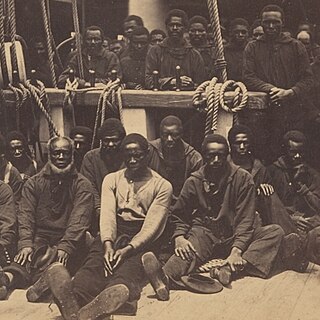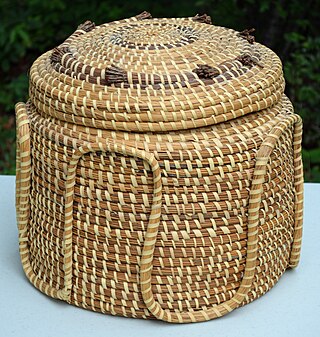Related Research Articles

Charleston is the most populous city in the U.S. state of South Carolina, the county seat of Charleston County, and the principal city in the Charleston metropolitan area. The city lies just south of the geographical midpoint of South Carolina's coastline on Charleston Harbor, an inlet of the Atlantic Ocean formed by the confluence of the Ashley, Cooper, and Wando rivers. Charleston had a population of 150,277 at the 2020 census. The 2020 population of the Charleston metropolitan area, comprising Berkeley, Charleston, and Dorchester counties, was 799,636 residents. It ranks as the third-largest metropolitan statistical area in the state, the 8th-largest in the Deep South and the 74th-largest in the United States.

Georgetown is the third oldest city in the U.S. state of South Carolina and the county seat of Georgetown County, in the Lowcountry. As of the 2010 census it had a population of 9,163. Located on Winyah Bay at the confluence of the Black, Great Pee Dee, Waccamaw, and Sampit rivers, Georgetown is the second largest seaport in South Carolina, handling over 960,000 tons of materials a year, while Charleston is the largest.

Gullah is a creole language spoken by the Gullah people, an African-American population living in coastal regions of South Carolina and Georgia as well as extreme northeastern Florida and the extreme southeast of North Carolina.

Slavery in the colonial history of the United States refers to the institution of slavery as it existed in the European colonies which eventually became part of the United States. In these colonies, slavery developed due to a combination of factors, primarily the labour demands for establishing and maintaining European colonies, which had resulted in the Atlantic slave trade. Slavery existed in every European colony in the Americas during the early modern period, and both Africans and indigenous peoples were victims of enslavement by European colonizers during the era.
The Stono Rebellion was a slave revolt that began on 9 September 1739, in the colony of South Carolina. It was the largest slave rebellion in the Southern Colonies, with 25 colonists and 35 to 50 African slaves killed. The uprising's leaders were likely from the Central African Kingdom of Kongo, as they were Catholic and some spoke Portuguese.

The Province of South Carolina, originally known as Clarendon Province, was a province of the Kingdom of Great Britain that existed in North America from 1712 to 1776. It was one of the five Southern colonies and one of the thirteen American colonies of the British Empire. The monarch of Great Britain was represented by the Governor of South Carolina, until the colonies declared independence on July 4, 1776.

The Gullah are an African American ethnic group who predominantly live in the Lowcountry region of the U.S. states of South Carolina, North Carolina, Georgia, and Florida within the coastal plain and the Sea Islands. Their language and culture have preserved a significant influence of Africanisms as a result of their historical geographic isolation and the community's relation to their shared history and identity.
South Carolina was one of the Thirteen Colonies that first formed the United States. European exploration of the area began in April 1540 with the Hernando de Soto expedition, which unwittingly introduced diseases that decimated the local Native American population. In 1663, the English Crown granted land to eight proprietors of what became the colony. The first settlers came to the Province of Carolina at the port of Charleston in 1670. They were mostly wealthy planters and their slaves coming from the English Caribbean colony of Barbados. By 1700 the colony was exporting deerskin, cattle, rice, and naval stores. The Province of Carolina was split into North and South Carolina in 1712. Pushing back the Native Americans in the Yamasee War (1715–1717), colonists next overthrew the proprietors' rule in the Revolution of 1719, seeking more direct representation. In 1719, South Carolina became a crown colony.

The colonial period of South Carolina saw the exploration and colonization of the region by European colonists during the early modern period, eventually resulting in the establishment of the Province of Carolina by English settlers in 1663, which was then divided to create the Province of South Carolina in 1712. European settlement in the region of modern-day South Carolina began on a large scale after 1651, when frontiersmen from the English colony of Virginia began to settle in the northern half of the region, while the southern half saw the immigration of plantation owners from Barbados, who established slave plantations which cultivated cash crops such as tobacco, cotton, rice and indigo.

Magnolia Plantation and Gardens is a historic house with gardens located on the Ashley River at 3550 Ashley River Road west of Ashley, Charleston County, South Carolina. It is one of the oldest plantations in the South, and listed on the National Register of Historic Places. Magnolia Plantation is located near Charleston and directly across the Ashley River from North Charleston. The house and gardens are open daily; an admission fee is charged.

The Cusabo were a group of American Indian tribes who lived along the coast of the Atlantic Ocean in what is now South Carolina, approximately between present-day Charleston and south to the Savannah River, at the time of European colonization. English colonists often referred to them as one of the Settlement Indians of South Carolina, tribes who "settled" among the colonists.

Joseph A. Opala, OR is an American historian noted for establishing the "Gullah Connection," the historical links between the indigenous people of the West African nation of Sierra Leone and the Gullah people of the Low Country region of South Carolina and Georgia in the United States.
Angolan Americans are an ethnic group of Americans of Angolan descent or Angolan immigrants. According to estimates, by the year 2000 there were 1,642 people descended from Angolan immigrants in the United States. However, the number of Angolan Americans is difficult to determine. Many African-Americans are descendants of Angolan enslaved people. In 1644, most of the 6,900 slaves bought on the African coast to clear the forests, lay roads, build houses and public buildings, and grow food came from the established stations in Angola.

The history of Charleston, South Carolina, is one of the longest and most diverse of any community in the United States, spanning hundreds of years of physical settlement beginning in 1670. Charleston was one of leading cities in the South from the colonial era to the Civil War in the 1860s. The city grew wealthy through the export of rice and, later, sea island cotton and it was the base for many wealthy merchants and landowners. Charleston was the capital of American slavery.
Sierra Leonean Americans are an ethnic group of Americans of full or partial Sierra Leonean ancestry. This includes Sierra Leone Creoles whose ancestors were African American Black Loyalists freed after fighting on the side of the British during the American Revolutionary War. Some African Americans trace their roots to indigenous enslaved Sierra Leoneans exported to the United States between the 18th and early 19th century. In particular, the Gullah people of partial Sierra Leonean ancestry, fled their owners and settled in parts of South Carolina, Georgia, and the Sea Islands, where they still retain their cultural heritage. The first wave of Sierra Leoneans to the United States, after the slavery period, was after the Sierra Leone Civil War in the 1990s and early 2000s. According to the American Community Survey, there are 34,161 Sierra Leonean immigrants living in the United States.
Buckra or Backra is a term of West African origin. It is mainly used in the Caribbean and the Southeast United States. Originally, it was used by slaves to address their white owners. Later, the meaning was broadened to generally describe white people.

Black South Carolinians are residents of the state of South Carolina who are of African ancestry. This article examines South Carolina's history with an emphasis on the lives, status, and contributions of African Americans. Enslaved Africans first arrived in the region in 1526, and the institution of slavery remained until the end of the Civil War in 1865. Until slavery's abolition, the free black population of South Carolina never exceeded 2%. Beginning during the Reconstruction Era, African Americans were elected to political offices in large numbers, leading to South Carolina's first majority-black government. Toward the end of the 1870s however, the Democratic Party regained power and passed laws aimed at disenfranchising African Americans, including the denial of the right to vote. Between the 1870s and 1960s, African Americans and whites lived segregated lives; people of color and whites were not allowed to attend the same schools or share public facilities. African Americans were treated as second-class citizens leading to the civil rights movement in the 1960s. In modern America, African Americans constitute 22% of the state's legislature, and in 2014, the state's first African American U.S. Senator since Reconstruction, Tim Scott, was elected. In 2015, the Confederate flag was removed from the South Carolina Statehouse after the Charleston church shooting.

Native Americans living in the American Southeast were enslaved through warfare and purchased by European colonists in North America throughout the 17th, 18th, and 19th centuries, as well as held in captivity through Spanish-organized forced labor systems in Florida. Emerging British colonies in Virginia, Carolina, and Georgia imported Native Americans and incorporated them into chattel slavery systems, where they intermixed with slaves of African descent, who would eventually come to outnumber them. The settlers' demand for slaves affected communities as far west as present-day Illinois and the Mississippi River and as far south as the Gulf Coast. European settlers exported tens of thousands of enslaved Native Americans outside the region to New England and the Caribbean.

Slavery in South Carolina was widespread and systemic even when compared to other slave states. From the Pickney cousins at the 1787 Constitutional Convention to the scores of slave traders active in Charleston for decade upon decade to the Rhett–Keitt axis of Fire-Eaters in the 1850s, South Carolina white men arguably did more than any other single faction devoted to perpetuating slavery in the United States.

The Gullah are African Americans who live in the Lowcountry region of the U.S. states of Georgia, Florida, South Carolina, and North Carolina, in both the coastal plain and the Sea Islands. They developed a creole language, also called Gullah, and a culture with some African influence.
References
- ↑ Judith Carney, Black Rice, pp. 3-4.
- 1 2 Cohan, William D. (2015). The Price of Silence. Simon and Schuster. ISBN 9781451681802.
- ↑ Kolchin, Peter (October 1999). "The World the Historians Made: Peter Wood's Black Majority in Historiographical Context". The South Carolina Historical Magazine. 100 (4): 368–78. JSTOR 27570404.
- ↑ "Profile A Loyal Opponent Ann Douglas: learning from the 1960s". Columbia Daily Spectator. October 25, 1984. Retrieved July 9, 2020.
Douglas later divorced her husband of 16 years, Peter H. Wood because "marriage did not suit Ann Douglas."
- ↑ Sounart, Christie (April 22, 2015). "Fenn Wins Pulitzer". Colorandan Magazine. Archived from the original on November 17, 2015. Retrieved November 11, 2015.

